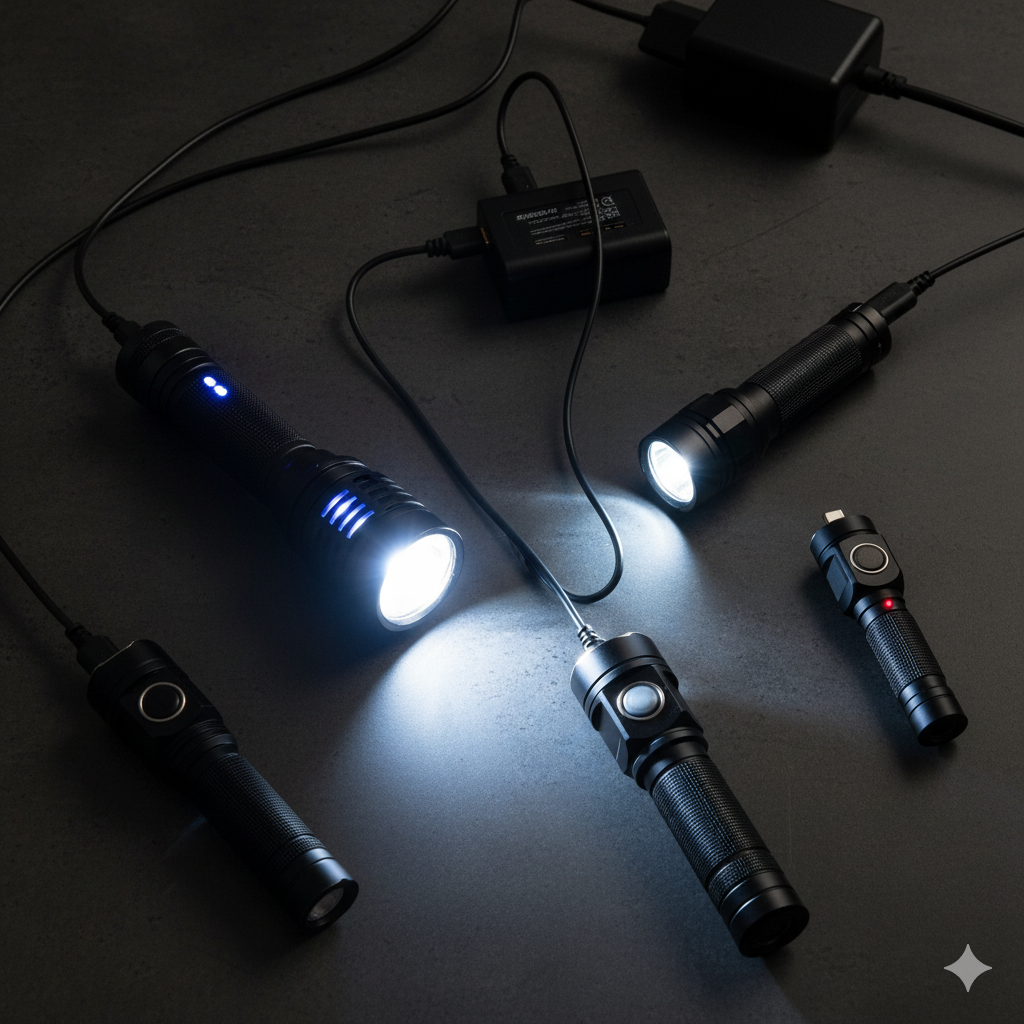Common Problems with Rechargeable Flashlights & Easy Fixes | 2025 Guide
Posted by Raymond on 3rd Nov 2025
Rechargeable flashlights have become a favorite for outdoor enthusiasts, emergency responders, and everyday users — combining power, sustainability, and convenience.
However, like any electronic device, they can occasionally run into problems such as charging failures, dim light output, or flickering beams.
In this article, we’ll explore the most common issues with rechargeable flashlights, explain why they happen, and show you how to fix them effectively.

1. Flashlight Won’t Turn On
Possible Causes
-
Battery is completely drained or damaged
-
Power switch malfunction
-
Poor battery contact or corrosion inside the flashlight
-
Driver circuit failure
How to Fix It
-
Check the battery: Fully charge it using the correct charger.
-
Inspect the contacts: Clean with a cotton swab and alcohol to remove oxidation.
-
Try a different battery (if removable).
-
If still not working, the driver board or tail switch may need replacement.
Pro Tip: For long-term use, always store flashlights at 50–70% charge to avoid battery degradation.
2. Flashlight Flickers or Cuts Out Intermittently
Possible Causes
-
Loose head, tail cap, or battery tube
-
Dirty or corroded threads
-
Faulty spring or driver connection
How to Fix It
| Step | Solution |
|---|---|
| 1 | Tighten all flashlight parts and ensure firm connections |
| 2 | Apply a small amount of conductive grease to threads |
| 3 | Clean all contact points using isopropyl alcohol |
| 4 | If flickering persists, inspect the driver circuit board for damage |
Note: Some flickering may occur if you’re using a partially discharged lithium-ion battery. Recharge before testing again.
3. Flashlight Doesn’t Charge Properly
Possible Causes
-
Faulty charging cable or port
-
Dust or debris inside USB port
-
Worn-out charging indicator (light stays red/green incorrectly)
-
Battery aging or cell damage
How to Fix It
-
Try a different USB cable and power source.
-
Use compressed air to clean the charging port.
-
If you notice abnormal heating, stop charging immediately.
-
For internal battery flashlights, open only if under manufacturer instructions or contact support.
Recommended Reading:
Learn more about battery health and charging cycles from the Battery University Guide.
4. Diminished Light Output (Even When Fully Charged)
Possible Causes
-
LED aging or heat damage
-
Dust or residue on the lens or reflector
-
Battery nearing end-of-life
How to Fix It
| Check | Action |
|---|---|
| Lens | Clean gently with microfiber cloth and isopropyl alcohol |
| Reflector | Avoid touching; use air blower to remove dust |
| LED | If burnt or yellowed, contact manufacturer for replacement |
| Battery | Replace if capacity has dropped significantly (e.g., <70% runtime) |
Tip: Some brands like TANK007 and Fenix use high-grade Cree LEDs designed for over 50,000 hours of use, minimizing degradation over time.
5. Overheating During Use or Charging
Possible Causes
-
Extended use at Turbo mode without cooling
-
Poor thermal regulation
-
Blocked heat vents or improper charging conditions
How to Fix It
-
Use high modes in short bursts to prevent heat buildup.
-
Keep flashlight in open air during charging.
-
Avoid using in direct sunlight or enclosed spaces.
-
Check if your flashlight has temperature control (ATC) — a feature in advanced models like TANK007 KC70 Plus that auto-regulates brightness to prevent overheating.
6. Battery Not Holding Charge Anymore
Possible Causes
-
Natural battery degradation after 300–500 cycles
-
Exposure to extreme heat or cold
-
Storing flashlight fully discharged
How to Fix It
-
Replace with a manufacturer-approved lithium-ion battery.
-
Store at room temperature and 50–70% charge for long-term storage.
-
Avoid cheap replacement cells — use protected 18650 or 21700 batteries for safety and longevity.
You can explore quality batteries and accessories at Fenix Lighting or Battery Junction.
7. Charging Indicator Malfunctions
Symptoms
-
Light remains red even when charged
-
Indicator doesn’t turn on at all
Possible Causes
-
Faulty indicator LED
-
Loose internal connection
-
Firmware or driver issue
Fix Options
-
Test by charging for a few hours, then measure output brightness.
-
If the light works but indicator is stuck, the issue is cosmetic.
-
For severe issues, contact manufacturer support for internal repair.
8. Preventive Maintenance Tips
To avoid future problems:
✅ Charge regularly — don’t let batteries sit empty for long periods.
✅ Keep threads and O-rings lubricated with silicone grease.
✅ Avoid over-tightening flashlight heads.
✅ Clean contacts every few months.
✅ Use the correct charger (5V 1–2A for USB models).
Proper maintenance can extend your rechargeable flashlight’s lifespan by up to 40–60%.
Comparison Table: Common Problems & Quick Fixes
| Problem | Likely Cause | Quick Fix |
|---|---|---|
| Won’t Turn On | Dead battery / bad contact | Recharge & clean terminals |
| Flickering | Loose connection | Tighten and clean threads |
| Not Charging | Faulty cable or port | Replace cable / clean port |
| Dim Output | Aged LED or battery | Replace or clean lens |
| Overheating | Prolonged turbo mode | Shorten usage / allow cooling |
| Battery Drains Fast | Aging cell | Replace with protected 18650 |
| Indicator Error | LED or circuit issue | Reset or manufacturer repair |
Conclusion
Rechargeable flashlights are built to last — but even the best models need occasional care.
By understanding the common problems and simple troubleshooting steps, you can restore performance and ensure reliable lighting for years to come.
Whether it’s a camping trip, night patrol, or emergency situation, proper maintenance and quality components make all the difference.
